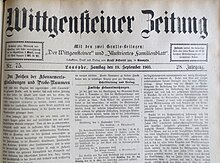Wittgensteiner Newspaper
The Wittgensteiner Zeitung was a regional weekly newspaper that was first published in Laasphe in 1876 and later appeared as the first daily newspaper in the Wittgenstein district .
founding
The editor Ernst Schmidt I (1835–1917), son of the carpenter and temporary castle soldier Jost Schmidt and his wife Christiane geb. Werner grew up in Laasphe and completed a four-year apprenticeship as a lithographer in Siegen from 1849 . After completing his training, he worked as a printer in Wuppertal for several years . In 1861 Schmidt returned to Wittgenstein and settled in Laasphe. With the acquisition of a lithographic press, he founded his printing business here, which he continuously expanded. His main clients included authorities, the princely administration and some steel works in the area of Laasphe. In the next few years, the company advanced to become the royal court printing house of the noble family residing at Wittgenstein Castle .
After 15 years of successful work, Schmidt was able to tackle a project that had motivated him to return home: With his sample number from June 19, 1876, Ernst Schmidt published a newspaper for the first time, initially under the name Wittgensteiner Wochenblatt. Organ im Lenne =, Lahn =, Dill = and Ederthal appeared and was able to attract a large number of subscribers straight away. From 1 July 1876, the newspaper appeared in direct competition with the in Berleburg appearing Kreisblatt Wittgenstein week on Saturday. An illustrated entertainment sheet was printed as a supplement for a small surcharge . The circulation was almost 1000 newspapers per issue and found interested buyers among former Wittgensteiners who had settled in the Siegerland , Bergisches Land and the Ruhr area .
Content and publication history
A short political newsreel, important negotiations of the Reichstag and the Prussian Landtag , the printing of sequel stories by popular writers, the publication of official notices, the transfer of reports from some correspondent offices, the reprinting of foreign newspaper reports and the result of own research on local topics were the most important things in addition to the printing of advertisements Content of the newspaper. Over the years, local reporting has been expanded significantly and a large number of local history topics have been dealt with.
On October 1, 1894, with the move into the new building in Bahnhofstrasse and the accompanying expansion of the company, the weekly newspaper was renamed Wittgensteiner Zeitung and now appeared twice a week, on Wednesdays and Saturdays. From April 1, 1919, the newspaper was printed three times a week; From April 1, 1928, the Wittgensteiner Zeitung appeared daily with a circulation of 5000 copies, making it the first daily newspaper in the Wittgenstein district. In 1924 it merged with the Erndtebrücker Zeitung, which was also founded by Ernst Schmidt in 1893 . During the Nazi era, the newspaper came under more and more political pressure, but in contrast to the Wittgensteiner Kreisblatt , which had to cease publication in 1933 in favor of the Wittgensteiner Nationalzeitung , it was able to last ten years longer. When all employees of the Laaspher newspaper publisher and the printing company were forced to work in other companies and the Wehrmacht drafted the then owner Ernst Schmidt III (1894–1959) into military service, the publication of the Wittgensteiner Zeitung had to be stopped on March 31, 1943.
Post-history
The newspaper name initially disappeared for six years, but then reappeared in a new newspaper: The Westfalenpost has been using the term Wittgensteiner Zeitung on its front page for its regional edition Wittgenstein since 1949 . Before that, it began its regional edition in 1946 with the title Wittgensteiner Nachrichten, but this did not catch on . The Ernst Schmidt printing company, which has produced a large number of regional historical publications since its foundation, remained family-owned and continued until 2004. The great-grandchildren of the company founder left the inventory unchanged at that time and present the historic printing company every year on an open day.
Lore
In addition to its previous version, the Wittgensteiner Zeitung is largely fully archived. The Bad Laasphe town archive has the years 1888 to 1892 (excluding 1890) of the Wittgensteiner Wochenblatt and the years from 1897 to 1942 of the Wittgensteiner Zeitung. Further evidence in Dortmund can be found in an inventory of Westphalian newspapers .
literature
Wilhelm Hartnack : One hundred years of printing by Ernst Schmidt in Laasphe 1861–1961 . In: Wittgenstein. Leaves of the Wittgensteiner Heimatverein eV, Vol. 49, Vol. 25, H. 1, Laasphe 1961, pp. 6-21.
Kurt Koszyk (ed.): Directory and holdings of Westphalian newspapers [Publications of the Historical Commission for Westphalia, Series XXXIV: Historical works on opinion formation and on the means of communication in Westphalia.] Aschendorffsche Verlagsbuchhandlung, Münster 1975.
Individual evidence
- ↑ Church book Ev. Laasphe Church, baptism No. 40/1835.
- ^ Wilhelm Hartnack: Hundred Years of Printing Works Ernst Schmidt in Laasphe 1861–1961 . In: Wittgenstein. Leaves of the Wittgensteiner Heimatverein eV, Vol. 49, Vol. 25, H. 1, Laasphe 1961, p. 7.
- ↑ Wolfgang Thiel: A piece of Wittgenstein newspaper history. In: Westfalenpost, Wittgenstein local section of September 3, 2013.
- ^ Benjamin Bernshausen: Printing like 152 years ago. In: Oberhessische Presse, Hinterland region, September 5, 2013.
- ↑ lh: Insights into the printing trade. In: Siegener Zeitung. August 15, 2016, accessed April 5, 2020 .
- ↑ Historical Schmidt printing works open to the Laasphe autumn market. September 15, 2019, accessed on April 5, 2020 (German).
- ^ Archivar: Open house in the historic Schmidt printing works, Bad Laasphe. In: siwiarchiv.de. September 18, 2018, accessed April 5, 2020 (German).
- ^ Historical printing works Schmidt invites you to the exhibition |. In: Südwestfalen Nachrichten. July 20, 2015, accessed on April 5, 2020 (German).
- ↑ Kurt Koszyk (ed.): Directory and inventory of Westphalian newspapers [Publications of the Historical Commission for Westphalia, Series XXXIV: Historical works on the formation of opinions and on the means of communication in Westphalia.] Aschendorffsche Verlagsbuchhandlung, Münster 1975, p. 60.

